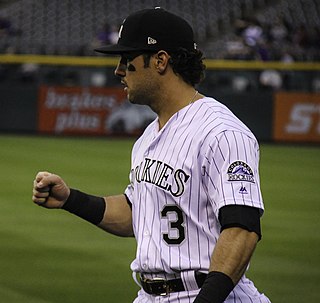Baseball statistics play an important role in evaluating the progress of a player or team.

In baseball, an at bat (AB) or time at bat is a batter's turn batting against a pitcher. An at bat is different from a plate appearance. A batter is credited with a plate appearance regardless of what happens during their turn at bat, but a batter is credited with an at bat only if that plate appearance does not have one of the results enumerated below. While at bats are used to calculate certain statistics, including batting average and slugging percentage, a player can qualify for the season-ending rankings in these categories only if they accumulate 502 plate appearances during the season.

A base on balls (BB), also known as a walk, occurs in baseball when a batter receives four pitches that the umpire calls balls, and is in turn awarded first base without the possibility of being called out. The base on balls is defined in Section 2.00 of baseball's Official Rules, and further detail is given in 6.08(a). It is considered a faux pas for a professional player to literally walk to first base; the batter-runner and any advancing runners normally jog on such a play.

In baseball statistics, on-base percentage (OBP), also known as on-base average/OBA, measures how frequently a batter reaches base. It is the ratio of the batter's times-on-base (TOB) to their number of plate appearances. OBP does not credit the batter for reaching base due to fielding error, fielder's choice, dropped/uncaught third strike, fielder's obstruction, or catcher's interference.
On-base plus slugging (OPS) is a sabermetric baseball statistic calculated as the sum of a player's on-base percentage and slugging percentage. The ability of a player both to get on base and to hit for power, two important offensive skills, are represented. An OPS of .900 or higher in Major League Baseball puts the player in the upper echelon of hitters. Typically, the league leader in OPS will score near, and sometimes above, the 1.000 mark.
Runs created (RC) is a baseball statistic invented by Bill James to estimate the number of runs a hitter contributes to his team.
Clay Davenport is a baseball sabermetrician who co-founded Baseball Prospectus (BP) in 1996. He co-edited several of the Baseball Prospectus annual volumes and is a writer for BaseballProspectus.com. Much of his work for BP was behind the scenes, where he maintained and implemented advanced statistics for the website.
In baseball, value over replacement player is a statistic popularized by Keith Woolner that demonstrates how much a hitter or pitcher contributes to their team in comparison to a replacement-level player who is an average fielder at that position and a below average hitter. A replacement player performs at "replacement level," which is the level of performance an average team can expect when trying to replace a player at minimal cost, also known as "freely available talent."
In baseball statistics, batting average against, or opponents' batting average is a statistic that measures a pitcher's ability to prevent hits during official at bats. It can alternatively be described as the league's hitters' combined batting average against the pitcher. It is calculated as: Hits Allowed divided by.

A box score is a chart used in baseball to present data about player achievement in a particular game. An abbreviated version of the box score, duplicated from the field scoreboard, is the line score. The Baseball Hall of Fame credits Henry Chadwick with the invention of the box score in 1858.
In baseball, defense-independent pitching statistics (DIPS) measure a pitcher's effectiveness based only on statistics that do not involve fielders. These include home runs allowed, strikeouts, hit batters, walks, and, more recently, fly ball percentage, ground ball percentage, and line drive percentage. By focusing on these statistics, which the pitcher has almost total control over, and ignoring what happens once a ball is put in play, which the pitcher has little control over, DIPS can offer a clearer picture of the pitcher's true ability.

Baseball Prospectus (BP) is an organization that publishes a website, BaseballProspectus.com, devoted to the sabermetric analysis of baseball. BP has a staff of regular columnists and provides advanced statistics as well as player and team performance projections on the site. Since 1996 the BP staff has also published a Baseball Prospectus annual as well as several other books devoted to baseball analysis and history.
Speed Score, often simply abbreviated to Spd, is a statistic used in Sabermetric studies to evaluate a baseball player's speed. It was invented by Bill James, and first appeared in the 1987 edition of the Bill James Baseball Abstract.
PECOTA, an acronym for Player Empirical Comparison and Optimization Test Algorithm, is a sabermetric system for forecasting Major League Baseball player performance. The word is a backronym based on the name of journeyman major league player Bill Pecota, who, with a lifetime batting average of .249, is perhaps representative of the typical PECOTA entry. PECOTA was developed by Nate Silver in 2002–2003 and introduced to the public in the book Baseball Prospectus 2003. Baseball Prospectus (BP) has owned PECOTA since 2003; Silver managed PECOTA from 2003 to 2009. Beginning in Spring 2009, BP assumed responsibility for producing the annual forecasts, making 2010 the first baseball season for which Silver played no role in producing PECOTA projections.
Base runs (BsR) is a baseball statistic invented by sabermetrician David Smyth to estimate the number of runs a team "should have" scored given their component offensive statistics, as well as the number of runs a hitter or pitcher creates or allows. It measures essentially the same thing as Bill James' runs created, but as sabermetrician Tom M. Tango points out, base runs models the reality of the run-scoring process "significantly better than any other run estimator".
In baseball, wOBA is a statistic, based on linear weights, designed to measure a player's overall offensive contributions per plate appearance. It is formed from taking the observed run values of various offensive events, dividing by a player's plate appearances, and scaling the result to be on the same scale as on-base percentage. Unlike statistics like OPS, wOBA attempts to assign the proper value for each type of hitting event. It was created by Tom Tango and his coauthors for The Book: Playing the Percentages in Baseball.
Wins Above Replacement or Wins Above Replacement Player, commonly abbreviated to WAR or WARP, is a non-standardized sabermetric baseball statistic developed to sum up "a player's total contributions to his team". A player's WAR value is claimed to be the number of additional wins his team has achieved above the number of expected team wins if that player were substituted with a replacement-level player: a player who may be added to the team for minimal cost and effort.

On-base plus slugging plus runs batted in (OPSBI) is a baseball statistic calculated as the normalized sum of a player's on-base percentage and slugging percentage added to their runs batted in. Former Major League Baseball general manager, Jim Bowden, created this statistic. Hall of Fame outfielder, Babe Ruth, holds both the single-season and career OPSBI records.

Michael Robert Tauchman is an American professional baseball outfielder for the San Francisco Giants of Major League Baseball (MLB). He previously played for the Colorado Rockies and New York Yankees. In his senior year of college in 2013 at Bradley University he batted .425, leading all NCAA Division I baseball players. The Rockies selected Tauchman in the 10th round of the 2013 MLB draft. He made his MLB debut in 2017.







